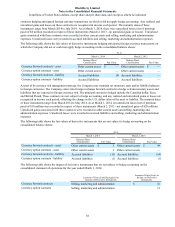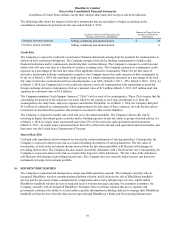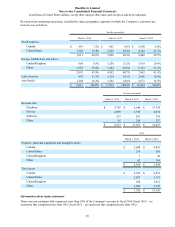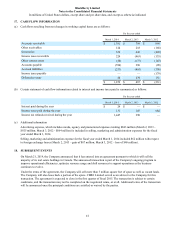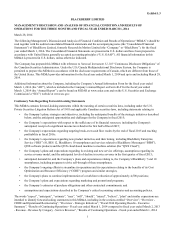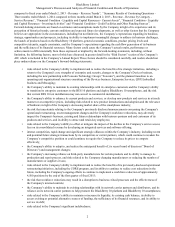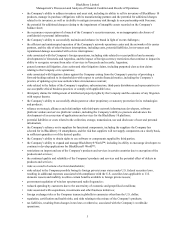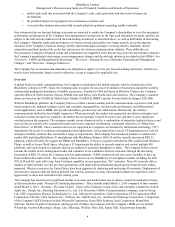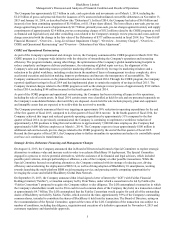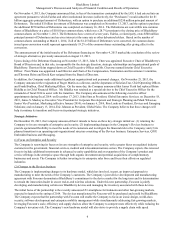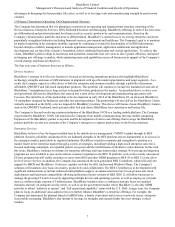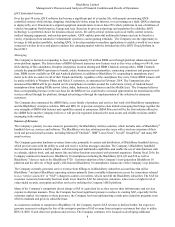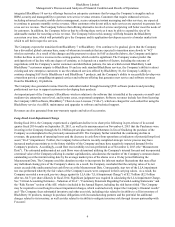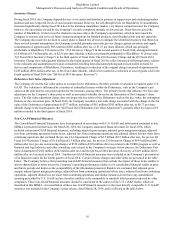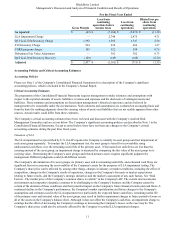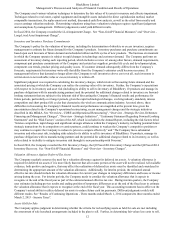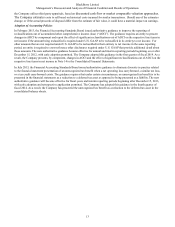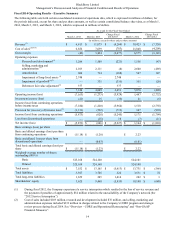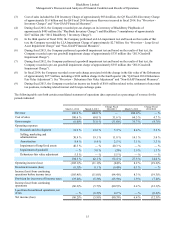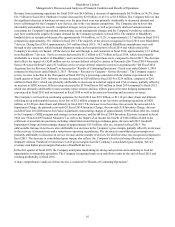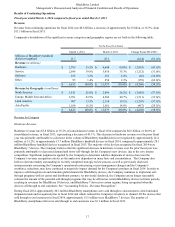Blackberry 2014 Annual Report Download - page 137
Download and view the complete annual report
Please find page 137 of the 2014 Blackberry annual report below. You can navigate through the pages in the report by either clicking on the pages listed below, or by using the keyword search tool below to find specific information within the annual report.
BlackBerry Limited
Management’s Discussion and Analysis of Financial Condition and Results of Operations
7
advantages in designing for faster product life cycles, as well as to leverage scale and manufacturing strength beyond current
volumes.
(3) Planned Transition to Operating Unit Organizational Structure
The Company has announced that it is planning to transition to an operating unit organizational structure consisting of the
Devices business, Enterprise Services, QNX Embedded business and Messaging. BlackBerry offerings in each of the four areas
are differentiated and positioned around key themes such as security, productivity and communications. Based on the
Company’s broad product portfolio and areas of differentiation, BlackBerry’s current focus is on serving enterprise customers,
particularly in regulated industries including financial services, government and healthcare. The Company’s goal is to maintain
its market leadership in the enterprise mobility segment by continuing to extend the functionality of its BES infrastructure
beyond enterprise mobility management, to include application management, application enablement and application
development and, on top of this extensive foundation, deliver additional horizontal and vertical applications. To achieve this
vision, BlackBerry plans to align its businesses and operations around the four core areas to drive greater efficiency and speed
in bringing new offerings to market, while optimizing assets and capabilities across all businesses in support of the Company’s
overall strategy and financial objectives.
The four core areas of business focus are as follows:
Devices business
BlackBerry’s strategy in its Devices business is focused on delivering smartphone products that highlight BlackBerry
technology strengths and areas of differentiation, in alignment with specific market opportunities and target segments. As a
result, the Company expects to offer choice to both the enterprise and consumer markets through a portfolio of premium,
affordable, QWERTY and full-touch smartphone products. This portfolio will continue to include the manufacture and sale of
BlackBerry 7 smartphones for as long as there is demand for these products in the market. As described above, to drive cost
and operational efficiencies, BlackBerry has entered into a joint device development and manufacturing agreement with
Foxconn. The initial focus of this partnership is the development in early 2014 of the BlackBerry Z3, an all-touch BlackBerry
10 smartphone designed for Indonesia and other fast-growing markets. The partnership will also deliver the BlackBerry Classic
(initially announced as the Q20), a device targeted for BlackBerry loyalists. This device will feature classic BlackBerry features
such as the QWERTY keyboard, track pad and utility belt and classic BlackBerry user experiences and battery life.
The Company is focused on driving continued adoption of the BlackBerry 10 OS as a leading mobile platform. The Company
expects that the BlackBerry 10 OS will transition the Company from mobile communications into true mobile computing.
Expansion of the BlackBerry partner ecosystem and the development of end-to-end offerings that leverage the BlackBerry
product portfolio are also key elements of the Company’s strategy to re-capture market share in the Devices business.
Enterprise Services
BlackBerry believes it has the largest installed base in the mobile device management (“MDM”) market through its BES
platform. Security, reliability and productivity are hallmark strengths of the BES platform and are instrumental to its success in
the enterprise market, particularly in regulated industries. BlackBerry intends to maintain and strengthen its position as a
market leader in the enterprise market through a variety of strategies, including building a high-touch enterprise sales force,
focused marketing campaigns, an expanded partner ecosystem and the identification of alternative sales channels. In line with
this focus, BlackBerry continues to enhance its enterprise offerings and long-term product strategy. New pricing and migration
programs are now available to ease and accelerate customer migration to the BES 10 platform, such as the recently announced
EZ pass program that will enable customers to move from BES and other MDM programs to BES 10 or BES 12 at the silver
level of service for free. In addition, the Company has announced the next-generation BES 12 platform, which will unify the
support for BBOS and BlackBerry 10 devices, together with that for iOS, Android and Windows Phone. The Company's
solutions will maintain a key focus on security, productivity and collaboration. The BES 12 platform is in development with
significant enhancements to include enhanced multi-platform support, an enhanced architecture for on-premise and cloud
deployments and backwards compatibility allowing unification of prior versions of BES. BES 12 will allow businesses to
manage the growing IT trend of securely supporting multiple devices and operating systems, as well as employees’ personal
devices, within a single corporate IT infrastructure. BlackBerry intends to have a continued strategic focus on regulated
industries that rely on stringent security needs, as well as on the government market where BlackBerry is the only MDM
provider to obtain “authority to operate” and “full operational capability” status with the U.S. DoD. Longer term, the Company
plans to focus on additional value-added services to further enhance BlackBerry’s enterprise offerings. For example, the
Company has announced the planned launch of eBBM Suite, a family of products and services to provide secure, enterprise-
class mobile messaging. BlackBerry also intends to leverage its strengths and expand further into new strategic vertical
markets.


